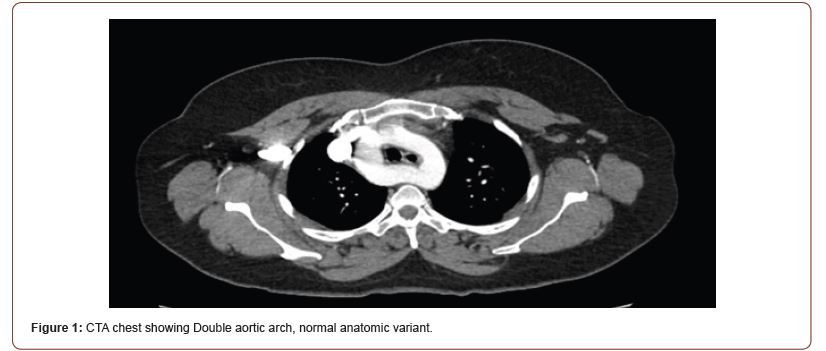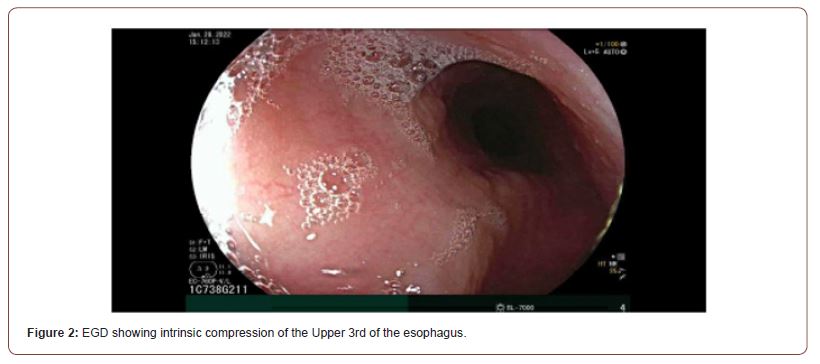Authored by Obiora Ezeudemba*,
Introduction
The double aortic arch (DAA) is a rare congenital vascular anomaly representing 1% of congenital heart disease [1]. It forms an anatomical vascular ring that encircles the thoracic portions of the trachea and esophagus. Typically, it is diagnosed in the neonatal period, often presenting with dyspnea or dysphagia due to tracheal and esophageal compression, respectively [1]. However, asympto matic DAA’s are known to persist into adulthood. In these cases, they are often incidentally diagnosed [2-5], but they can also reveal themselves with delayed onset of the compressive symptoms [6-8]. We report the case of a 49-year-old female with a previously diagnosed asymptomatic DAA that later became symptomatic with dysphagia requiring surgical relief.
Case Presentation


A 49-year-old female with a known history of DAA now presenting with dysphagia to solid food. The patient’s DAA was diagnosed incidentally when she presented with pleuritic chest pain and shortness of breath. At that time there were concerns for pulmonary embolism, so she underwent a CTA chest which revealed a DAA with co-dominance of the left and right aortic branches. Given the patient’s lack of symptoms, the decision was made to not pursue further work up or treatment [Figure 1]. However, over a course of years, the patient started having dysphagia with a sense of food getting stuck on her esophagus causing a persistent pain around the xiphoid area. She had an EGD, which showed extrinsic compression of the esophagus [Figure 2].
Discussion
Aortic arch anomalies include the vascular ring. DAA, a subtype representing 25-38% of rings therein [9-11], was first described by Wollman in 1939 and surgically corrected by Gross in 1945 [12, 13]. It results from improper embryologic development of the fourth aortic arches. Edwards’ Hypothetical Double Arch model illustrates how failure of the hypothetical right arch to involute results in persistence of the bifurcated ascending aorta. The left and right arch each course around opposite sides of the trachea and esophagus before rejoining to form the descending aorta, which is still typically left-sided [14]. Diagnosis is often made in the neonatal period, usually informed by respiratory symptoms such as stridor, wheezing, and coughing, which are almost always present, and in some cases, will co-present with gastrointestinal symptoms, primarily choking with feeds [1, 9, 15, 16]. Importantly, DAA usually occurs without associated cardiac anomalies [15, 16]. Accordingly, treatment outcomes are excellent in pediatric populations after surgical correction [15, 17].
The question of surgical treatment arises when DAA presents asymptomatically. In an era of widespread use of cross-sectional imaging modalities, these cases are becoming more common [2-5]. A conservative approach would be to monitor these patients for the development of compressive symptoms and only then surgically correct them. However, life-threatening complications of otherwise asymptomatic DAA have been described. Notably, prolonged nasogastric intubation in these patients can lead to ulceration and subsequent arterial-esophageal fistula formation [18-20]. These fistulae can harbor life-threatening infections and even lead to massive upper gastrointestinal bleeds with subsequent death by exsanguination. Thus, even a completely asymptomatic DAA can contribute to morbidity and mortality. The patient described in this case had her DAA incidentally diagnosed nearly ten years before it became symptomatic. Her close monitoring and follow-up within the same system facilitated targeted workup and prompt surgical correction once her compressive symptoms finally manifested.s
Conclusion
DAA is a diagnosis that is classically described within the context of pediatric cardiology. However, widespread use of cross-sectional imaging has identified an increasing number of asymptomatic adult cases. Thus, DAA remains relevant in fields of adult medicine, particularly gastroenterology. We have outlined a case wherein close monitoring and follow-up successfully mitigated dysphagia-related morbidity and avoided redundant workup. It highlights the importance of viewing asymptomatic DAA as more than a benign anatomical variant. Future studies into incidentally diagnosed DAA would be useful to explore a possible risk reduction in their morbidity and mortality through subsequent scheduled monitoring.
To read more about this article...Open access Journal of Anaesthesia & Surgery
Please follow the URL to access more information about this article
https://irispublishers.com/asoaj/fulltext/asymptomatic-double-aortic-arch-in-an-adult.ID.000575.php
To know more about our Journals...Iris Publishers
To know about Open Access Publishers





No comments:
Post a Comment